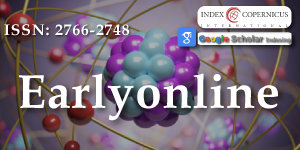The Modelling of Dielectric Relaxation under Microwave Treatment into Porous, Humidified Body
Main Article Content
Abstract
According to the method of local special averaging, a porous medium is considered as a continuum of material points with averaged or effective physical properties. The equations of electrodynamics are written in the reduced form by the definition of the generalized dielectric constant. To describe the dielectric properties of a modelled three-phase porous medium, the possibility of using the pulse relaxation method is demonstrated. Based on the dielectric properties by the using of pulse relaxation function, the polarization and current via delay functions are defined depending on the volume fraction of the saturation of the porous medium with liquid phases. The time limits of the proposed relaxation functions are analysed and in the harmonic approximation of the field amplitudes, a transparent expression for the generalized dielectric displacement vector is written in terms of physical content. Within the framework of the effective macroscopic field approximation according to the cluster approach, a method of averaging local equations of the electromagnetic field is demonstrated. The generalized complex dynamic dielectric constant for the composite porous body is determined. The compatibility conditions of the demonstrated method for describing of electromagnetic processes in a heterogeneous multiphase porous medium are recorded.
Article Details
Copyright (c) 2025 Holubets TV.

This work is licensed under a Creative Commons Attribution 4.0 International License.
1. Burak JY, Kushnir RM, editors. Modelling and optimisation in thermomechanics of electrically conductive heterogeneous bodies [Internet]. Lviv: Spolom; 2006;1–2:474.
2. Hachkevych OR, Terlets’kyi RF, Holubets’ TV. Calculation of effective electrophysical characteristics of moistened porous materials. J Math Sci. 2010;168(5):699–711.
3. Gawin D. Modelling coupled thermal-humidity phenomena in building materials and elements. ZN 853. Lodz: Lodz University of Technology Publishing House. 2000.
4. Landau LD, Lifshitz EM. Electrodynamics of continuous media. Moscow: Nauka. 1982;632. Available from: https://ui.adsabs.harvard.edu/abs/1982MINTF...8.....L/abstract
5. Böttcher CJF, Bordewijk P. Theory of electric polarization. Dielectrics in time-dependent fields. Amsterdam: Elsevier Scientific. 1978;561:2. Available from: https://api.pageplace.de/preview/DT0400.9780444600691_A23669214/preview-9780444600691_A23669214.pdf
6. Gubkin AN. Physics of dielectrics. Theory of dielectric polarization in static and alternating electric fields. Moscow: Vysshaya Shkola. 1971;268.
7. Riffe DM. Canonical models of dielectric response [Internet]. Utah State University; 2016;66. Available from: http://www.physics.usu.edu/riffe/bio/index.htm
8. Korn G, Korn T. Handbook of mathematics. Moscow: Nauka. 1978;831. Available from: https://www.scirp.org/reference/referencespapers?referenceid=2241028
9. Howes AH, Whitaker S. The spatial averaging theorem revisited. Chem Eng Sci. 1980;23(12):1613–23.
10. Sihvola AH. Electromagnetic mixing formulas and applications. London: The Institution of Electrical Engineers. 1999; 284. Available from: https://www.bibliovault.org/BV.book.epl?ISBN=9780852967720
11. Landauer R. Electrical conductivity in inhomogeneous media. In: Garland JC, Tanner DB, editors. Electrical transport and optical properties of inhomogeneous media. AIP Conf Proc. 1978;40:2–43. Available from: https://ui.adsabs.harvard.edu/abs/1978AIPC...40....2L/abstract
12. Hilfer R, Widjajakusuma J, Biswal B. Macroscopic dielectric constant for microstructures of sedimentary rocks. Granul Matter. 2000;2:137–41. Available from: https://doi.org/10.1007/s100359900035
13. Nettelblad B, Niklasson GA. Simple expressions of the dielectric response of suspensions in an electrolyte. J Colloid Interface Sci. 1996;181:165–8. Available from: https://www.academia.edu/48102416/Simple_Expressions_for_the_Dielectric_Response_of_Suspensions_in_an_Electrolyte
14. Jones SB, Friedman SP. Particle shape effects on the effective permittivity of anisotropic or isotropic media consisting of aligned or randomly oriented ellipsoidal particles. Water Resour Res. 2000;36(10):2821–33. Available from: https://doi.org/10.1029/2000WR900198
15. Holubets T, Terletskiy R, Yuzevych V. The analytical expressions to describe wave propagation and heat release during microwave treatment of a porous inhomogeneous plate based on the W.K.B. solution model. Adv Mater Sci. 2025;23(1):69–81. Available from: https://doi.org/10.2478/adms-2023-0005
16. Katselenenbaum BZ. High-frequency electrodynamics. Fundamentals of mathematical apparatus. Moscow: Nauka. 1966;240.
17. Godin OA. WKB approximation for atmospheric waves. J Fluid Mech. 2015;777:260–90. Available from: https://doi.org/10.1017/jfm.2015.367
18. Takuma T, Tochaumnat B. Electric fields in composite dielectric and their application. London & New York: Springer Dordrecht Heidelberg. 2010;179. Available from: https://doi.org/10.1007/978-90-481-9392-9
19. Rjlundzija BM, Djordjevic AR. Electromagnetic modeling of composite metallic and dielectric structures. Norwood: Artech House. 2002;408. Available from: https://books.google.co.in/books/about/Electromagnetic_Modeling_of_Composite_Me.html?id=zdR47nZ7oK8C&redir_esc=y





